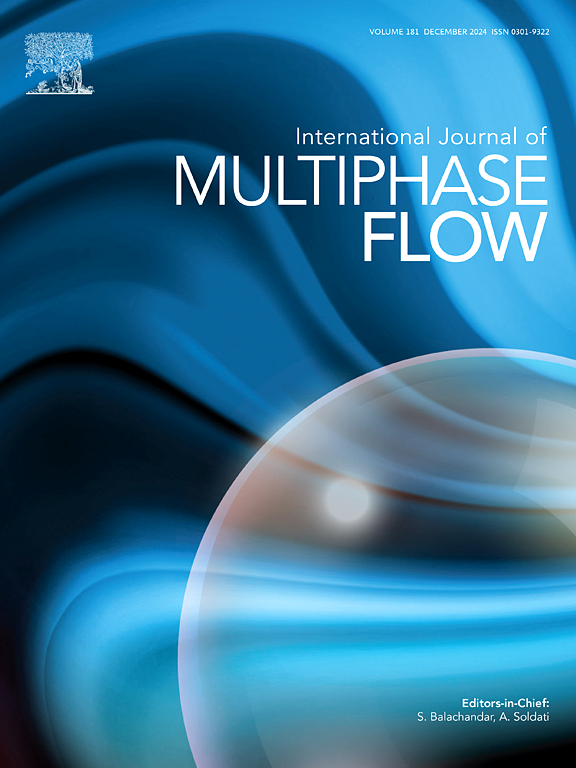基于MRT-LBM的考虑电场的仿生表面液滴蒸发
IF 3.6
2区 工程技术
Q1 MECHANICS
International Journal of Multiphase Flow
Pub Date : 2025-04-18
DOI:10.1016/j.ijmultiphaseflow.2025.105267
引用次数: 0
摘要
电场下过热固体表面上的液滴碰撞是自然界和工业生产过程中的普遍现象。电场强度和纹理表面形态是影响液滴蒸发的关键因素。然而,人们对液滴如何在电场作用下冲击纹理表面并在其上蒸发的了解还很有限。本研究基于多相和热多重松弛时间晶格玻尔兹曼法,结合漏电介质模型,研究了液滴在电场作用下撞击过热的生物启发表面时的形态变化。生物启发表面的特点是有重入柱,是根据春蜱的角质层设计的。电毛细管数、韦伯数和微结构形态等因素都考虑到了液滴碰撞和蒸发的影响。结果表明,在薄膜蒸发过程中,增强的电场会促进液滴蒸发。然而,在有核沸腾的情况下,增强电场并不能持续促进液滴蒸发。当基底温度与临界温度之比(Th/Tc)为 0.90 且韦伯数为 85.5 时,即使没有电场,液滴也能突破结构的能量障碍。在有电场的情况下,Th/Tc=0.90、1.02、1.06 时,过热生物启发表面上的液滴寿命最短,分别为微柱表面的 76.27%、46.36% 和 56.78%。这项研究为精确控制电场以增强液滴蒸发提供了宝贵的见解。本文章由计算机程序翻译,如有差异,请以英文原文为准。

Droplet evaporation on bio-inspired surfaces considering the electric field based on MRT-LBM
Droplet collisions on superheated solid surfaces under the electric field are universal phenomenon in both nature and industrial production processes. The electric field intensity and textured surface morphology are crucial factors influencing droplet evaporation. However, the understanding of how droplets impact and evaporate on textured surfaces with the electric field is limited. The research investigates how droplets morphologically change upon impacting superheated bio-inspired surfaces under the electric field, based on the multiphase and thermal multiple-relaxation-time lattice Boltzmann method that incorporates the leaky dielectric model. The bio-inspired surfaces, characterized by reentrant pillars, are designed based on the cuticles of springtails. Factors such as electric capillary number, Weber number, and microstructural morphology are taken into account for the effects of droplet collision and evaporation. The results indicate that an enhanced electric field promotes droplet evaporation during film evaporation. Nevertheless, in the context of nucleate boiling, the enhanced electric field does not consistently facilitate droplet evaporation. When the ratio of substrate temperature to critical temperature is 0.90 and the Weber number is 85.5, the droplet breaks through the energy barriers of the structure, even without the electric field. Droplet lifetime on the superheated bio-inspired surface is shortest when with the electric field, measuring 76.27 %, 46.36 %, and 56.78 % of that on the micro-pillar surface, respectively. This study provides valuable insights into accurately controlling electric fields to enhance the evaporation of droplets.
求助全文
通过发布文献求助,成功后即可免费获取论文全文。
去求助
来源期刊
CiteScore
7.30
自引率
10.50%
发文量
244
审稿时长
4 months
期刊介绍:
The International Journal of Multiphase Flow publishes analytical, numerical and experimental articles of lasting interest. The scope of the journal includes all aspects of mass, momentum and energy exchange phenomena among different phases such as occur in disperse flows, gas–liquid and liquid–liquid flows, flows in porous media, boiling, granular flows and others.
The journal publishes full papers, brief communications and conference announcements.

 求助内容:
求助内容: 应助结果提醒方式:
应助结果提醒方式:


